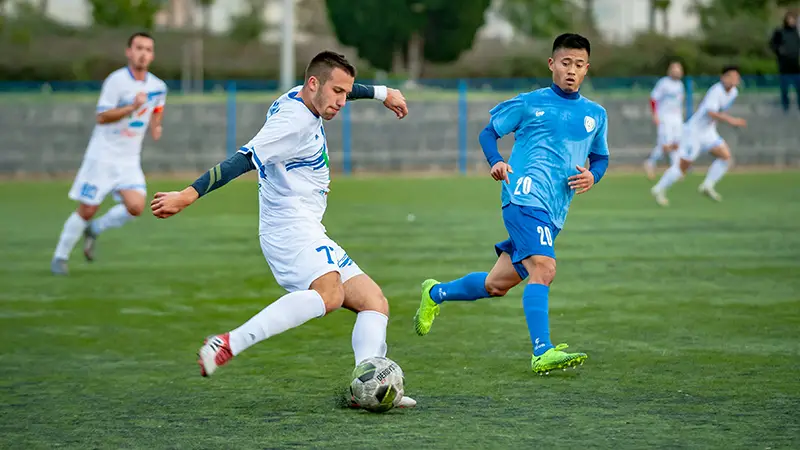In soccer, dead ball situations play a crucial role in determining the outcome of a match. Understanding the rules and nuances of dead ball scenarios can give a team a significant advantage on the field.
From free kicks to corner kicks, each dead ball situation presents a unique opportunity for teams to score or defend strategically.
Mastering the dead ball rules requires not only knowledge of the regulations but also the ability to execute precise plays under pressure. Whether it’s a direct free kick near the penalty box or a well-placed corner kick, these moments often decide the fate of a game.
By delving into the intricacies of soccer’s dead ball rules, players and fans alike can gain a deeper appreciation for the tactical aspects of the sport.
Types of Dead Ball Situations in Soccer
Dead ball situations play a crucial role in soccer matches, often providing teams with strategic opportunities to score goals or defend effectively.
Understanding the various types of dead ball situations is essential for players and coaches to capitalize on these instances and gain an advantage over their opponents.
Free Kicks
Free kicks are awarded to a team following a foul committed by the opposing team. These set-piece opportunities can occur from various points on the field, with the most common being direct and indirect free kicks.
In a direct free kick, the player can shoot directly on goal, while in an indirect free kick, another player must touch the ball before a goal can be scored.
Mastering free kicks requires precision in striking the ball and effective coordination among teammates to create scoring opportunities.
Penalty Kicks
Penalty kicks are awarded when a foul is committed inside the penalty box, resulting in a one-on-one situation between the attacking player and the goalkeeper. The ball is placed on the penalty spot, and the player has a clear shot at goal with only the goalkeeper to beat.
Penalty kicks require mental focus, composure, and accurate finishing to convert the chance into a goal, making them high-pressure situations that can sway the outcome of a match.
Throw-Ins
When the ball goes out of play over the touchline, a throw-in is awarded to the team that did not touch the ball last. The player taking the throw-in must keep both feet on the ground and throw the ball over their head using both hands.
Throw-ins provide teams with opportunities to advance the ball up the field strategically, allowing players to set up attacking plays or retain possession by distributing the ball to teammates.
Goal Kicks
Goal kicks are awarded to the defending team when the attacking team plays the ball over the goal line without scoring. The ball is placed inside the six-yard box, and the goalkeeper takes the kick to restart play.
Goal kicks allow the defending team to regroup, build from the back, and transition into attacking play by distributing the ball to teammates strategically.
Corner Kicks
Corner kicks are awarded to the attacking team when the defending team plays the ball over the goal line without scoring. A player takes the corner kick from the corner arc, aiming to deliver the ball into the penalty box for teammates to score.
Corner kicks are prime scoring opportunities, requiring precise delivery and intelligent movement from attacking players to convert the chance into a goal, making them critical dead ball situations in soccer.
How a Soccer Ball Becomes Dead
In soccer, a ball becomes dead in various situations during a match, impacting the flow of play and providing strategic opportunities for teams to regroup or seize advantageous positions.
Balls That Exit the Field of Play
When a soccer ball exits the field of play, either over the touchlines (sidelines) or the goal lines, it is considered dead. This occurs during instances such as throw-ins, goal kicks, and corner kicks, where the ball needs to be put back into play legally by the appropriate team.
Fouls and Infringements
Fouls and infringements by players can also result in the soccer ball becoming dead. When a foul is committed, play is stopped, and the ball is considered dead until the free kick or penalty kick is taken, depending on the severity of the offense.
Infringements like offside calls or handballs can similarly lead to the ball becoming dead.
Other Stoppage Reasons
Apart from balls exiting the field and fouls, there are other reasons for the soccer ball to become dead. These include injuries to players that require medical attention, significant delays such as player substitutions, or when the referee needs to intervene for disciplinary actions.
In these instances, play is halted, and the ball is considered dead until the situation is resolved, and play can resume.
Responsibilities and Roles During Dead Ball Scenarios
During dead ball scenarios in soccer, various roles and responsibilities come into play for both referees and players, crucially impacting the outcome of matches:
Role of the Referee
When it comes to dead ball scenarios in soccer, the referee plays a critical role in maintaining fairness and enforcing the rules.
It’s the referee’s responsibility to signal when the ball is in play or when play needs to stop, ensuring that all decisions are made according to the regulations of the game.
During dead ball situations like free kicks or penalty kicks, the referee must position themselves appropriately to monitor the action and intervene if necessary.
Responsibilities of Players
Players on the field have specific responsibilities during dead ball situations to maximize their team’s advantage.
Whether it’s quickly setting up for a free kick, marking opponents during a corner kick, or positioning themselves strategically during a goal kick, players need to be alert and proactive.
Clear communication among teammates is essential to coordinate movements and execute set plays effectively, leading to scoring opportunities or defensive stability.
Positioning and Strategy
Positioning and strategy are key elements for teams during dead ball scenarios in soccer. Players must adhere to predetermined tactics depending on whether they are defending or attacking.
Proper positioning ensures that players cover key areas of the field, mark opponents tightly, and create options for passing or shooting.
Teams often rehearse specific dead ball routines during training sessions to enhance their coordination and execution when the situations arise in competitive matches.
Restarting Play After a Dead Ball
After a dead ball situation in soccer, play is restarted in various ways depending on the circumstances.
Direct and Indirect Free Kicks
- Direct Free Kicks: These are awarded for fouls deemed punishable, allowing a player to shoot directly on goal without needing another player to touch the ball first.
- Indirect Free Kicks: In these situations, the ball must touch another player before a goal can be scored, offering opportunities for strategic set plays or short passes before a shot on goal.
Procedures for a Penalty Kick
When a penalty kick is awarded for a foul inside the penalty area, the ball is placed on the penalty spot, and only the goalkeeper can defend the shot. The player taking the penalty kick has one chance to score from 12 yards out.
Executing Throw-Ins and Goal Kicks
- Throw-Ins: When the ball crosses the touchline, the team that did not touch it last has the right to a throw-in. The player must have both feet on the ground and deliver the throw from behind their head.
- Goal Kicks: These are awarded when the attacking team is responsible for the ball going out beyond the goal line. The defending team can take a goal kick from anywhere inside the six-yard box.
Taking a Corner Kick Correctly
Corner kicks are awarded when the defending team plays the ball out over its own goal line. These set-piece opportunities are taken from the corner quadrant nearest where the ball went out.
Players can strategically place the ball for a teammate to take a shot on goal or create scoring chances with well-rehearsed routines.
Common Violations and Misunderstandings
In the realm of soccer dead ball rules, certain violations and misunderstandings can impact the flow and fairness of the game.
Encroachment During Free Kicks
Encroachment during free kicks is a common violation where players from the defending team move closer to the ball than the regulations allow. This can obstruct the free kick taker or create an unfair advantage.
The referee enforces a minimum distance that defending players must maintain until the free kick is taken. Failure to comply can result in a retake of the free kick or disciplinary action.
Incorrect Throw-In Techniques
Incorrect throw-in techniques often lead to violations during matches. A throw-in must be taken with both feet on the ground, using both hands to deliver the ball from behind and over the head.
Failure to adhere to these rules may result in the opposing team gaining possession or the throw-in being awarded to the other team. It’s crucial for players to master proper throw-in techniques to maintain game integrity.
Common Misconceptions in Penalty Kicks
Penalty kicks come with their fair share of misconceptions. While many believe that a penalty taker must wait for the referee’s signal to take the kick, this is not a mandatory requirement. Players can take the penalty kick as soon as they are ready, within the rules’ guidelines.
Additionally, encroachment by defenders during penalty kicks is often overlooked but can lead to a retake if it interferes with the outcome. Understanding these nuances can help players navigate penalty kick situations effectively.
Frequently Asked Questions
What are dead ball situations in soccer?
In soccer, dead ball situations occur when the ball is not in play, such as after a foul, out of bounds, or before a kick-off.
What are the different types of dead ball situations in soccer?
Common dead ball scenarios in soccer include free kicks, penalty kicks, throw-ins, goal kicks, and corner kicks.
How are dead ball situations restarted in soccer?
Dead ball situations in soccer are restarted with direct or indirect free kicks, penalty kicks, throw-ins, goal kicks, or corner kicks.
Why are dead ball situations important in soccer?
Dead ball situations in soccer provide significant scoring opportunities and require precision, coordination, and strategic positioning for success.
How can players enhance performance in dead ball situations?
Players can improve dead ball performance by practicing precise free kicks, accurate penalty kicks, proper throw-in techniques, precise goal kick distribution, and varied corner kick routines.
Conclusion
To improve performance in soccer dead ball situations, focus on key strategies for free kicks, penalty kicks, throw-ins, goal kicks, and corner kicks.
Enhance precision and power in free kicks, penalty kick accuracy under pressure, proper technique in throw-ins, accurate distribution in goal kicks, and varied routines for corner kicks.
Mastering these components through practice, coordination, and strategic planning can lead to success on the field by creating scoring opportunities and maintaining possession effectively.
Ultimately, mastering these dead ball rules will give you a competitive edge on the soccer field, enabling you to capitalize on scoring chances and control possession during crucial moments of the game.
By honing these aspects of dead ball situations, players can significantly impact their performance on the field. This strategic approach will enhance scoring opportunities and improve overall possession dynamics during critical game junctures.








Brice Petersen